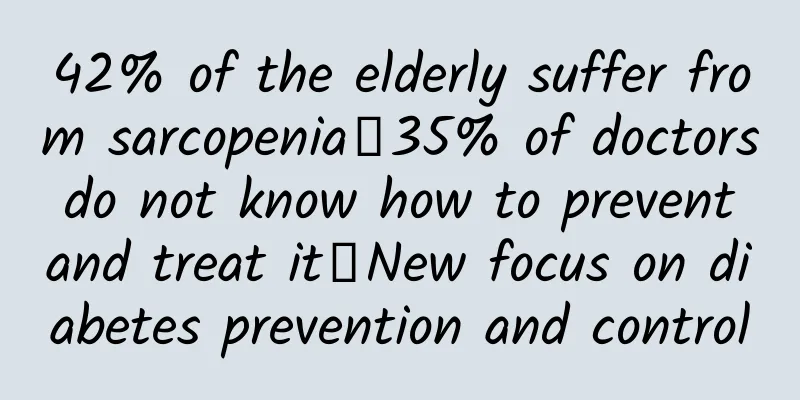42% of the elderly suffer from sarcopenia|35% of doctors do not know how to prevent and treat it|New focus on diabetes prevention and control

|
Mr. Li has been suffering from diabetes for many years. He has been taking more and more medicines, but his blood sugar is always unstable. Some experts said that losing weight can help control blood sugar, so Mr. Li made up his mind to lose weight. After several months of hard work, he lost 10 kilograms, but became increasingly weak. After he accidentally fell, his family sent him to the hospital for examination. At first, even the doctors didn’t know what was happening to him. It was only after a consultation with multiple departments that he was diagnosed with sarcopenia. Mr. Li was confused. Isn't losing weight a good thing? Why did he get sarcopenia for no apparent reason? 1. What is sarcopenia ? Sarcopenia, the full name of which is muscle loss, is an age-related muscle degenerative disease. Its main characteristics are: decreased muscle content (muscle mass), decreased muscle strength (muscle power) and/or physical dysfunction. It is estimated that by 2050, 500 million people worldwide will suffer from sarcopenia! According to statistics, among the elderly people over 60 years old in my country, 1 in 7 suffers from sarcopenia; among the elderly people over 80 years old, 2 in 5 suffer from sarcopenia! What is heartbreaking is that about 35% of medical staff in our country lack attention and understanding of sarcopenia! 2. Why are diabetic patients more likely to suffer from sarcopenia ? 1. Compared with healthy people, diabetic patients often experience a decline in muscle function and quality earlier and faster. 2. Diabetic patients are more likely to lose weight blindly and become too low in weight due to medication. Low weight can increase the risk of sarcopenia. 3. Diabetic patients are more likely to suffer from nutritional imbalance due to strict dietary control. When carbohydrate and protein intake is insufficient, the occurrence and development of sarcopenia will be accelerated. 3. What are the dangers of diabetes combined with sarcopenia ? 1. Blood sugar is more difficult to control : The abnormal glucose metabolism of diabetic patients with sarcopenia will be more serious, which will undoubtedly increase the difficulty of blood sugar control. 2. Increased risk of osteoporosis : There is evidence that diabetic patients with sarcopenia are more likely to develop osteoporosis, especially female patients. 3. Increased risk of fractures : Diabetic patients with sarcopenia often suffer fractures due to accidental falls, which sometimes even lead to disability. 4. Risk of cardiovascular complications : Sarcopenia can increase the risk of cardiovascular disease by affecting obesity, insulin resistance, chronic inflammation, etc. 4. How can diabetic patients prevent sarcopenia ? 1. Early exercise intervention : Exercise intervention based on resistance training can effectively increase muscle mass, improve muscle strength and improve physical function. In addition to prevention, exercise is still the preferred treatment for sarcopenia. Diabetic patients can choose to train with dumbbells, elastic bands, push-ups, squats, equipment, etc. according to their personal conditions under the guidance of professionals. The recommended exercise frequency is 2-3 times a week, every other day, 30-60 minutes each time. Tips: Patients with no exercise background should start with low intensity. 2. Pay attention to nutritional balance : Avoid extreme carbon control in diet and ensure sufficient energy intake (recommended 105-126 kJ/kg) to reduce the risk of sarcopenia; Sufficient daily protein intake (range 1.2-1.5 g/(kg·d)) can improve muscle mass and strength, with priority given to foods such as milk, eggs, fish, lean meat, and beans; Patients with sarcopenia and vitamin D deficiency should supplement vitamin D appropriately. 3. Rational selection of drugs : Studies have shown that SGLT2i (dapagliflozin, empagliflozin, etc.) and GLP-1RA (liraglutide, semaglutide, etc.) help maintain the percentage of muscle mass in patients with type 2 diabetes. Diabetic patients at risk of sarcopenia can give priority to these drugs under the guidance of a physician. 5. How to detect sarcopenia early ? Sarcopenia has an insidious onset and is not easy to detect, and most sarcopenia patients will not take the initiative to go to the hospital for treatment. Careful observation of the following signs can help detect sarcopenia early. 1. Worsening grip strength : Changes in grip strength can reflect changes in muscle strength, and muscle strength is currently the primary indicator for diagnosing sarcopenia. Low grip strength can be diagnosed if the grip strength is less than 28 kg for men and less than 18 kg for women. 2. The calf becomes thinner : Use a soft tape measure to measure the circumference of the thickest part of the calf. The result is called the calf circumference. Calf circumference and hand grip strength are commonly used as community screening tools for sarcopenia. Men with a diameter less than 34cm and women with a diameter less than 33cm should go to the hospital for treatment. 3. Walking slower : The walking speed is simple and easy, which can reflect the level of physical function. A walking speed of less than 1m/s is called a low walking speed. If the patient has difficulty walking, he or she can perform 5 chair stand and sit tests. If the completion time is ≥12s, it is a physical dysfunction. Tips: If you have any questions about your muscle strength, muscle mass, etc., it is recommended that patients go to the nearest community hospital to seek help from a general practitioner! Conclusion : Don’t let your muscles slip away Diabetes combined with sarcopenia can lead to a significant decline in the patient's quality of life and a significant increase in the incidence of complications. Early diagnosis and early comprehensive intervention in diet and exercise are the best ways to deal with sarcopenia. Remember what Uncle Li taught you: controlling sugar intake does not mean losing weight blindly! Protecting your muscles is the first line of defense to preserve your quality of life in your later years. Note: The content of this article is based on the "Guidelines for the Diagnosis and Treatment of Diabetes in the Elderly in China (2024 Edition)", "Guidelines for the Diagnosis and Treatment of Sarcopenia in China (2024 Edition)" and other public medical literature. It is only used for health education and cannot replace diagnosis and treatment! The cases in the article are fictitious and are intended to indicate the risk of disease! |
>>: This generation of young people has been targeted by gout...
Recommend
What are the treatments for heavy menstrual flow?
Menstruation is a physiological phenomenon unique...
Is rhinitis prone to recurrence in summer? Listen to what Qingbitang says
In the hot summer, when you walk from the 30-degr...
What are the symptoms of liver fire in women
Excessive liver fire is quite common in daily lif...
Why is tuna frozen? How to defrost tuna
Tuna is tender and delicious, with high nutrition...
There is still a little bleeding three weeks after the abortion.
After an unexpected pregnancy, most women choose ...
Is surgery necessary for uterine polyps?
The uterus is not only an organ in the body, but ...
Anechoic areas in the ovary
Some women choose to have a physical examination ...
How should vaginitis in the elderly be treated?
Vaginitis is a very common gynecological disease....
Woman with sore knees and calves
Nowadays, more and more people are troubled by kn...
What does transparent leucorrhea mean?
In the eyes of many women, some women's issue...
What should I do if I can't sleep after learning I have the disease?
Since learning that she had ovarian cancer, Zhang...
What should you pay attention to during intercourse after cervical repair?
First of all, I would like to remind all women to...
Afraid of heart disease, experts tell you how to check
In the outpatient clinic, we often encounter pati...









